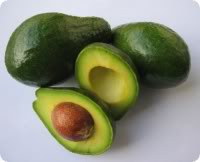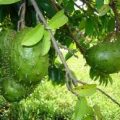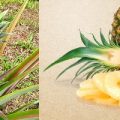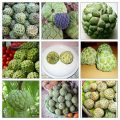Avocado (Persea americana Mill.) is considered one of the most nutritious fruits in the world. In the Philippines, however, it has not attained the popularity enjoyed by other fruits despite its early introduction in 1890. One reason for this is that it lacks that sweetness of such popular fruits as mango, banana and pineapple. To improve its taste to suit their palate, Filipinos eat avocado with sugar and milk. If Filipinos acquire the taste for the fruit, avocado can become a good market fruit and therefore source of income of small farmers in the countryside. Later, export market for fruit can be developed. Aside from the nutritional benefits that can be derived from the fruits, its various parts have several medicinal uses.

Economic Importance
Avocado fruit is a rich source of Vitamin A and contains little amount of Vitamin B complex and E.
The ripe fruit can be eaten on hand and can be used in preparing fruit salads, flavor for ice-creams, filling for sandwiches and quick desserts.
Various parts of the crop have medicinal benefits. The leaves when boiled is a remedy for diarrhea. Pulp is used to hasten the formation of pus in wounds and even stimulate menstrual flow. Seeds can be smashed and be used as fillers for toothache.
Varieties/Strains
There are a number of cultivars locally developed, (Table 1) however, avocado is botanically divided into three races: Mexican, West Indian and Guatemalan.
Table 1: List of Avocado Varieties, Approved by the Philippine National Seed Industry Council.
| Name | Characteristics |
| 1. NSIC 95-Av-02 (Parker) | Prolific yielder, (500-700 fruits/season) bear fruit both during the late season & off season; fruit of excellent eating quality, possessing flesh texture (smooth & firm) w/ scanty fiber with flavor buttery & nutty; high edible portion of 87.0%. a fruit weighs 561.4 g |
| 2. NSIC 97-Av-03 (RCF Morado) | Yield, 300-400 fruits/season. Significant small seed (about 9% of the total fruit weight skin easily peels off; testa does not adhere to the flesh with high edible portion (80.8%). A fruit weighs 391.5 g |
Three Races:
1. Mexican Race – the leaves are aniso-scented, small and sharp at the apex. The seed is large with thin coats, either separated or adhering to the cotyledons. The surface of the cotyledons is smooth. The fruits are small with smooth rind adhering to the pulp which are purplish black in color.
The Mexican race is very resistant to cold, heat and low humidity but least tolerant to soil salinity.
Different varieties of Mexican race had been introduced into the Philippines and that include “Ganther”, “Gottried”, “Northrop” and “Puobla.”
2. West Indian Race – there is no aniso-scent of foliage. The fruit varies in sizes and has poor shipping quality. The skin is thin, smooth and leathery. The seed is relatively large and often loose in the cavity. The seedcoat is separated and the cotyledons are rough on surface. The fruit stem is short and has a unique “nailhead” configuration on the fruit point of attachment. It is least tolerant to low humidity and can stand soil salinity. The varieties that belong to West Indian race are: Family, Pollock, Cardinal, Wester, Waldin and Balwin
Family – the fruit is obovate, necked, large, smooth and glossy, deep purple to blood red with light yellow dots when ripe. The skin is thick and adheres closely to the pulp. The pulp is battery with creamy yellow, and with good flavor and quality. The seed is oblong to conical, large and loose, and the seedcoats adhere closely to the cotyledons.
Pollock – the fruit of this West Indian variety is obovate to oblong, large, smooth, glossy, light green with longitudinal yellow lining and small greenish yellow dots. The skin is thick, the pulp is firm, smooth, fine in texture, deep yellow, has rich flavor and good eating quality. The seed is small, conical and loose.
Cardinal – its fruit is bottleshaped, large (weighs about 370 g), and has smooth, glossy purple skin when ripe. The skin is medium thick and easily peels off. The flesh is thick, yellow relatively fibrous. The seeds are small, and loose in the cavity.
Wester – the fruit is roundish oblate and medium-sized. The skin is smooth and glossy, leathery, deep purple with maroon russet dots when ripe, adhering closely to flesh. The flesh is firm, yellow, with few fibers and of rich flavor and of good quality. The seed is broadly ovate and large, and fits tightly in the cavity.
Lopena – this is a local variety which also belongs to West Indian race. Its fruit is round, medium-sized (weighs about 300 g), and has rough, blackish, purple skin when ripe. The skin is medium thick and peels off easily. Flesh is medium thick, yellow and makes up about 70% of the whole fruit’s weight. The seed is small and tight in the cavity.
3. Guatemalan Race – this type has a thick rind producing dull, large and rough fruits. The seed is small and invariably tight fitting. The shell and the skin of this variety is thicker than the Mexican and West Indian varieties aside from the fact that it has a good shipping quality. The meat is drier than the meat of the West Indian variety. The surface of the cotyledons is smooth and the fruit is usually borned on the long stem. The varieties introduced locally are: Dickinson, Tertoh, Lyon, Taft and Tumin. Other introduced varieties are Sharpless, Blackman, Solano, Spinks and Taylor.
Lyon – the fruit is oblong ovate and large weighing 800 g. The skin is green with fairly numerous, whitish tenticels, thick and brittle, and separated from flesh. The pulp is pale creamy yellow, tinged with green near the skin, buttery and nutly, has few fibers and has a good coating quality. The seed is very small and oblong and the seedcoats adhere to the cotyledons.
Fuerte Variety – this is apparently a natural Mexican and Guatemalan hybrid.
Other varieties that have been introduced into the Philippines and successfully growing are the following: Cyrus, Quality, Doughlas, Miami, Vegas, Cummins, De Leon, and Commodore.
Cyrus – the fruit is oblong to pyriform and medium-sized. The skin is smooth, glossy, greenish yellow or yellowish green with yellow dots when ripe, membraneous and separated from flesh. The flesh is firm, smooth and fine in texture, yellow and of rich flavor and good quality. The seed is loose. The seedcoat adheres closely to the flesh and partially cracked at the apex.
Quality – the fruit is obovate and small. The skin is smooth and glossy, greenish yellow with small maroon dots when ripe and adheres to the flesh. The flesh is white yellow, rather fibrous, and of good flavor and quality. The seed is oblong, small to medium-sized and tightly fitting in the cavity. The seedcoats adhere closely to the flesh and cotyledons.
Doughlas – the fruit is obovate to pyriform, necked and medium-sized. The skin is smooth, glossy, deep purple with yellow dots when ripe, thin, adhering closely to flesh but easily peel off. The flesh is creamy yellow, firm with rich flavor and quality. The seed is broad conical to oval, loose and the seedcoats adhering closely to the cotyledons.
Vega – this wariety was introduced from Cuba in 1906. the fruit is obovate to broad pyriform and medium-sized. The skin is rough, glossy, yellowish green with yellowish dots when ripe, thick, separates from flesh coarse and brittle. The flesh is cream colored, with few fibers and rich flavor and quality. The seed is heart-shaped and fits tightly in the cavity. The seedcoats adhere closely to the flesh and cotyledons.
Cummins – the fruit is roundish oblate and small to medium-sized. The skin is rough, slightly glossy, dark purple with yellow and russet sots when ripe, firm and separates readily from the flesh. The flesh is firm, greenish yellow to pale yellow, and of good flavor and excellent quality. The seed is broad, conical, medium-sized, and fits tightly in the cavity. The seedcoat adheres closely to the flesh and cotyledons.
De Leon No. 1 – its fruit is ovoid, medium-sized (weighs about 330 g), and has round, purple skin when ripe. The skin is medium thick and peels off easily. Flesh is medium thick and yellowish in color. Seed is medium-sized and tight in the cavity.
Commodore – the fruit is obovate to pyriform and small. The skin is glossy, deep purple with small yellow dots when ripe, coarsely granular, brittle and thin. The flesh is light yellow, rather fibrous, with rich flavor and fair quality. The seed is broad, conical, small, fitting, tightly in the cavity and with seedcoats adhering closely to the cotyledons.
Soil and Climatic Requirements
Soil – it can be grown over a wide range of soil types provided with adequate drainage. For best production, deep, fertile, well-drained soils, particularly sandy or alluvial loam soils and have a pH of neutral or slightly acid are suited for avocado.
Climate – a climate with alternating wet and dry season and with minimum annual rainfall requirement of 750 – 1,000 mm is recommended.
It does not thrive well in places exposed to strong, excessively hot and dry winds.
Elevation –
West Indian Varieties – are very tender and are adapted to low and medium elevations up to 1,000 m above sea level.
Mexican Varieties – are the hardiest with respect to cold weather and can grow at elevations of 1,500 – 3,000 m above sea level.
Guatemalan Varieties – are intermediate and can grow at elevations of 1,000 – 2,000 m above sea level.
Generally, avocado can grow well from sea level to about 1,500 m in places with short or no dry season. Where dry season exceeds 4 to 5 months, irrigation is very important.
Cultural Requirements
Seed Selection and Germination – seed used should be obtained from healthy and vigorous trees. Select large seeded fruits especially when intended for rootstocks to maintain seedlings quality. It is recommended to plant it at once. If in case it cannot be planted/propagated immediately, store it in the moist sand or sphagnum moss.
Seeds are sown with the pointed ends up and with about one-fourth of their length above soil level. Germination starts 2-3 weeks from planting or sowing.
Care of Seedlings – the seedlings planted in containers should be provided with temporary shade. Direct exposure to sunlight may injure the seeds and the emerging one.
Water the seedlings regularly and if the need arises, spray it with the recommended dosages of pesticides to control pests.
Propagation – avocado can be propagated either sexually (by seeds) or asexually (by marcotting, inarching, grafting, and budding). However, propagation through seeds is not recommended for the resulting plants do not come true-to-type. Sexual propagation is good only for seedling rootstocks.
Marcotting – marcotting is not recommended process, because it is laborious, slow and some varieties do not respond well to this method. Besides, it takes 4 to 5 months of marcots to produce roots.
Inarching – gives a very high percentage of success as good results can be obtained in both dry and wet seasons. There is no need of special skills & tools. Among its advantages are tree to be propagated must be near at hand, necessity of bringing the seedling to the branch to be inarched. A relatively slow process, it takes 8 to 62 weeks or more to separate the inarches from the tree. Inarching is recommended for small scale propagation only.
Tongue inarching is a modified form of inarching recommended for avocado. This method is the combination of the ordinary inarching & tongue grafting. In this method, the line of contact between the cambia of stock and scion is greatly increased, thereby shortening the period from inarching to the rate of severing the inarched branches by 4 weeks or more. Those overgrown seedlings not suitable for grafting and budding can be used. Tongue inarching is consider a supplementary method for use during the rainy season when grafting and budding cannot be done very successfully.
Cleft Grafting – this is recommended for larger scale propagation. Use rootstock about 6 to 12 months old with a stem as large as pencil. Select mature budstick with a well-developed terminal buds.
Shield Budding – it is also recommended for larger propagation. This method is fast and resulting plants are precarious, low spreading and uniform. Seedling stock for this purpose should be about 23 – 30 cm tall and its stem is pencil-size. Select mature budwood to facilitate easy bending.
Land Preparation
Backyard Planting – dig a hole wide and large enough to accommodate the ball of the planting material.
Orchard Plantation – prepare the land thoroughly by plowing 2 to 3 times followed by two or more harrowings until good a tilth is attained. Stake the field with the recommended distance of planting.
Planting – transplant the planting materials when they are about 50 cm tall. The recommended distance of planting is 9 meters apart accommodating 125 seedlings per hectare. Align the trees in all directions and finally pack the base of the plant to let the root system recover early.
Planting can be done anytime of the year but the best time is during the onset of the rainy season. If planted during dry season provide the seedlings with irrigation and partial shade.
Irrigation – in areas with distinct wet and dry seasons, water supply is very essential during dry months, especially during the first 2 or 3 years of the trees. Young trees are very sensitive to heat and water should be given regularly. Irrigate every two weeks.
Fertilization – in the absence of specific soil analysis, the general recommendation of fertilization can be follows. Apply 100-200 g Ammonium Sulfate (or about 50-100 g Urea) per tree, one month after planting. Apply the same amount every six months thereafter. The amount of fertilizer should increase as the trees grow bigger. However, reduce the recommendation when supplemented with manure or compost. At the start of fruiting, about 500 gm of complete fertilizer (14-14-14) should be applied per tree twice a year. For full bearing trees (15 to 20 years old) apply at least 2 kg of complete fertilizer per tree per year. Half of the amount should be applied at the start of the rainy season and the season half at the end of the rainy season.
Pruning – avocado trees require only little training when properly established from the field. Only those decayed or dead branches that hamper its growth should be pruned. These varieties which have a vertical growth can be pruned judiciously to encourage horizontal growth.
However, pruning should be minimized when the trees start to bear fruits.
Intercropping and Covercropping – it is advantageous to use the vacant spaces in between the main crop by planting bananas, coffee, papaya, pineapple or short season crops (e.g. corn, mango) and vegetable (e.g. eggplant, tomato) crops. Intercropping contributes income benefits, helps improve the land through cultivation and suppresses the growth of weeds. Stop planting intercrops when no longer feasible. Leguminous cover crops can be planted at this period.
Diseases and Their Control
The following are the major diseases of avocado:
Root Rot – caused by fungus Phytophthora cinnamomi. This is commonly infecting trees in narrowly drained water logged areas as it attacks & rapidly kills the roots. The symptoms are yellowing of leaves, sparse foliage, wilting of leaves, die back of shoots and eventually the whole tree dies. The best method of control is the prevention of conditions conducive to the growth of the fungus.
Anthracnose or Blackspot – this disease is caused by the fungus Colletotrichum gloesporioides Penz. and attacks the twigs, leaves, flowers and fruits. This disease can be noticed when the fruits start to ripen. Symptoms can be seen as brown or tan-colored spots on green colored fruits and lighter spots on purple-colored fruits. Timely spraying with 4-4-100 Bordeaux mixture or Copper Sulfate (3 lb/100 gallon of water) should be done in monthly intervals or 3 months before the fruit matures. Frequent spraying is advisable when rainfall is heavy.
Cercospora Fruit Spot or Blotch – it is caused by the fungus Cercospora purpuren Cooke, and produces a slightly brown to dark brown spots confined on the rind of the fruits. On the leaves, the spots are angular, brown to chocolate brown and from irregular patches. This disease can be controlled by spraying the fruits and leaves with 6-6-100 or 4-4-100 Bordeaux mixture or wettable Cuprous Oxide (155 lb/100 gal. water) or basic Copper Sulfate (3 lb/100 gal. water).
Stem End Rot – caused by Diplodia natalensis Pole Evans. is a common disease of fruits in transit which lead to huge losses. The rot starts at the stem end and develops as fruits soften. Avoid wounding of the fruits during harvesting and packing to minimize the disease.
Scab – this disease is caused by Sphacelonia perseae Jerkins, and attacks fruits, young leaves, and shoots. It is a circular to irregular spots, brown to purplish brown, later fading to light brown. Scab can be sprayed with 6-6-100 Bordeaux mixture or wettable Cuprous Oxide (1.5 lb/100 gal. water) before the flowers appear during flowering, and 2 to 4 weeks later.
Insect Pests and Their Control
Mealybug (Planococcus lilacinus CKII)
It infects avocado as one of its many host plants. It is found on the young shoots or on the peduncle of fruits, from which it sucks plant sap. Fruits may drop prematurely if heavily infested by mealybugs. On avacado, it seldom needs control measures.
Moths
Avocado barkborer, Aegeria sp.
Often, a bearing avocado tree may be found with a trunk-wound oozing with jelled plant sap in which may be found caterpillar excretal pellets this bleeding is caused by the larvae of a clear winged moth Aegeria sp. The caterpillar feeds underneath the bark and may penetrate into the wood. The attack trees become unthrifty and may break easily in strong wind
Control: Simply excuse the wound, extract the larvae and paint the wounded trunk with coal tar.
Tussock Moth, Dasychira mendosa Hubner
The caterpillars feed on the leaves and/or on the flowers. These are voracious leaf/flower feeders causing mild defoliation or extensure destruction of flowers. These are locally called “tilas”. It has many host plants including guava, beans, pechay, santol, mango. Because of its polyphagous natural enemy, a branchonid larvae parasite , Apanteles sp. If infestation is serious enough, spray with appropriate insecticide
Atlas Moth, Attacus atlas Linn
Its caterpillar feed on the young and maturity leaves causing serious defoliation.
Control: Parasitized by Tricholygiabom bisum Bech, a large gray course-harred tiachinid fly. The strategy is done this way. Upon sensing the presence of the adult fly parasite, the caterpillar swings the anterior portion of the its body continuously from side to side to discourage the fly from approaching nevertheless, the fly will mount at the back of the caterpillars and lay many eggs, individually glued on the back of the caterpillar. The parasite maggots that hatch from the egg penetrate into and completely consume the inside tissues of the caterpillar which die in the cocoon before it could actually pupate. The maggot get out of the dead caterpillar and pupate inside the cocoon.
Bugs (Helopeltis vakeri Pop)
It infests the tender shoots and young fruits. The area around where it has fed collapses and turn black. Severely damaged young shoots die back.
Can be controlled with appropriate insecticide spray, if necessary.
Fruit fly (Dacus dorsalis Hendel)
Usually attack the fruits that are left to ripen on the tree. Fruit oviposites their eggs on the fruits and larvae destroy the fruits making them unfit for human consumption. This can be controlled by spraying any insecticides.
Harvesting, Packing and Marketing
Seedling tree bear fruits in 4 to 5 years after planting. Asexually propagated ones come into bearing much earlier.
Fruits are harvested from April to September and from one season to the next depending on the size of the previous crop, condition and flowering season.
Full bearing avacado tree may yield from a few to as much as 1, 200 fruits per crop year. An average of 500-600 fruits a year may be considered a fair yield.
The fruits of avocado are very perishable and it needs great care during harvesting operation. Fruit maturity is indicated by the appearance of reddish streaks in the case of purple varieties and green to light green on green varieties. Another indication of maturity is when the fruit produces a hallow-sound when tapped with the fingers.
Harvesting should be done by using a picking pole with a wire hook a net basket attached to its end to avoid injury of fruits.
Fruits should be placed in basket or box lined with packing materials such as dried straw, banana leaves, etc. for short distant shipment. For long distant shipment, the fruits should be packed individually with soft paper and packed in a single layered boxes.
Outlets are local markets and near-by stores. It can also be sold direct to processors or processing companies interested in the product.
Source: bpi.da.gov.ph







Thank you for your open infos. I am a Filipina resident in Japan and as Avocado is a very widely eaten fruit in Europe, I am interested of cultivating them but I don’t have any experience in farming. I think avocado needs very little tending and good for amateur farming enthusiasts.